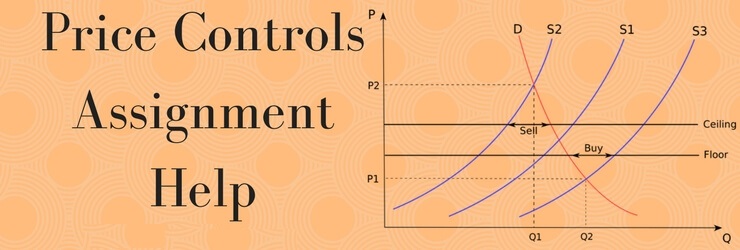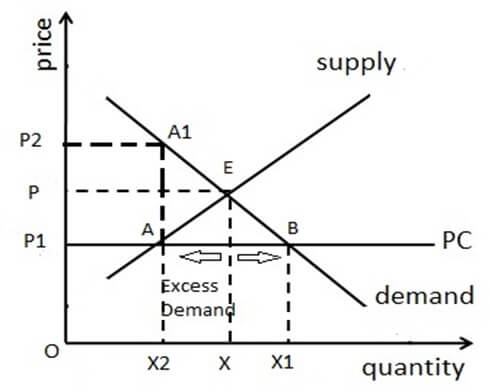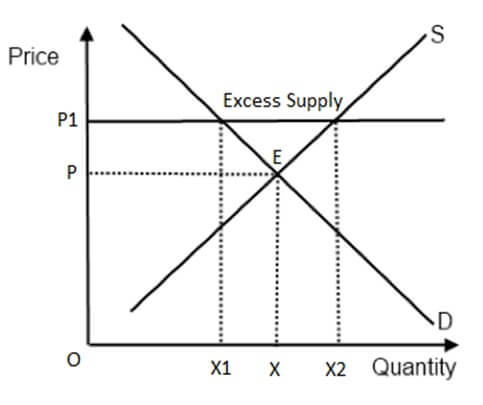Price Controls Assignment Help
What is Price controls?
Price controls are restrictions levied by the government on the prices of many commodities or services with the intend to maintain the affordability of necessities like staple food and goods, curb extreme hikes in prices while shortages and slowing the rate of inflation or with the intend to provide a minimum income to the providers of specific goods and services. Without the intervention of the government, the equilibrium price and quantity is determined where the demand and supply meet.
Types of price controls?
There are two types of price controls:
- Price ceiling - It is the maximum price which is legal and can be charged on a good or a service. This is mostly lower than the equilibrium price.
- Price floor - It is the minimum price which is legal and should be charged on a good or a service. It is mostly higher than the equilibrium price.
What is the difference between price floor and price ceiling?
Price floor deals with the minimum price whereas price floor deals with the maximum price. Mainly price floor is imposed by the government on agricultural produce or wage rates to save the workers and producers from exploitation. Minimum wage is the most important example of price floor. Whereas price ceiling is imposed mainly on life savings drugs or staple foods, etc.
Price Controls Assignment Help Through Online Tutoring and Guided Sessions at MyAssignmentHelp

To understand the concept of price control we first need to understand what is demand and what is supply.
- demand - it is defined as the quantity of a commodity demanded at a certain price during any particular period of time.
- supply - It is defined as the quantity of commodity which is actually offered for sale at a given price during some particular time.
Price Ceiling
As discussed above Price ceilings are government enforced price preventing suppliers from fixing the prices at higher levels than the price fixed by the government. Price ceilings revises the market supply and demand.
Price Ceiling Examples
Price ceiling mainly exist on staple foods like sugar, wheat, rice, salt, etc. In developing countries. It also exists on house rents, fuel, etc.
For price ceiling to be binding, it must be set below the equilibrium price. When the maximum price is set below the equilibrium price, there will be excess demand or the storage of supply. Actual quantity exchanged will fall below its equilibrium level.

Binding Price Ceiling
Here we can see the price ceiling which is denoted by the letters PC where:
- Point E = it is point of market equilibrium where demand curve intersects the supply curve.
- OP = it is the equilibrium price.
- OX = It is the equilibrium quantity.
- OP1= It is the legal maximum price. To be binding, it is necessarily set below the Equilibrium price OP. At Price OP1, quantity demanded is for OX1 units and quantity supplied is of OX2 units.
- X2 X1= there is excess demand or shortage of supply of X2 X1 at the maximum price.
- 6. OX2 = it is the quantity actually exchanged. black marketers will buy OX2 quantity at price OP1 from producers and sell it at price OP2 to the customers. black marketers earn profit calculated as:
Profit of black marketers = amt. Consumers pay- amt. Producers get
For more information on price ceiling as a price control method contact assignmenthippo.com. Our best tutors will cater to all your needs and solve all your doubts and queries. You can also get help for assignments here at assignmenthippo.com. You can contact us 24/7 and we will help you.
Price Floor
Price floor is a government imposed price control which puts limits on how low the price of a commodity can be charged for a product. A price floor should be higher than the equilibrium price for it to be effective.
The most common form of price floor is imposed as the minimum wage rule which implies the minimum price that can be paid for labour. Price floors are often implemented on agricultural produce in order to protect farmers.
If price floor is set above free-market equilibrium price, then as a result there will be a surplus of the commodity in the market. This price floor will lead to a more inefficient market too and also cause a decreased total economic surplus.
Price Floor Examples
Minimum wage law which establishes the minimum price in the labour market, minimum support price which protects the interest of farmers.
For price floor to be binding it must be set above the equilibrium price. When minimum price is set above the equilibrium price, there will be surplus or excess supply. Actual quantity exchanged will fall below the equilibrium quantity.

Binding Price Floor
Point E = it is the equilibrium point attained by the intersection of demand and supply curves, D and S, respectively. It gives OP as the equilibrium price and OX as the equilibrium quantity.
OP1= minimum price imposed on the commodity by the government. It is binding minimum legal price. At this price demand is for OX1 units and supply is of OX2 units.
X1X2 = excess supply or surplus of the commodity. It shows shortages of demand for the commodity at price OP1.
Thus we see that the process of price control is very complex and quite confusing. The analysis of different methods is hard to understand. But we arehere to help you at assignmenthippo.com where you can contact us at anytime and we will help you with your queries and helping you out with your assignments. assignmenthippo.com respect that you can’t lose on marks and that is why we arehere to provide you with the best facilities and qualitative results. You can also take online classes from the best tutors. We believe in providing the best services for your satisfaction. My assignment serves its clients with good and satisfying work and with complete dedication.
